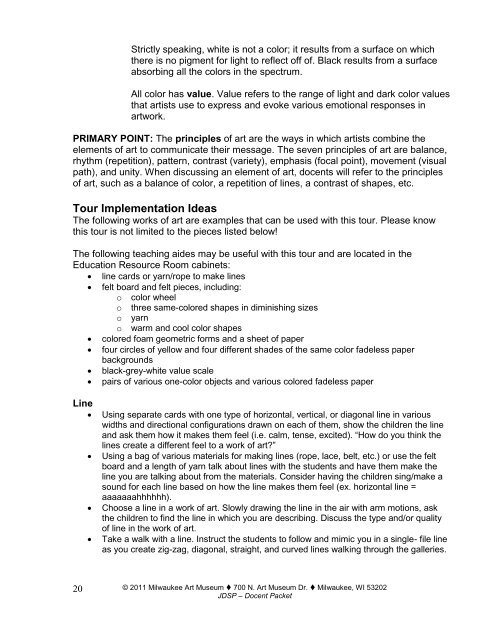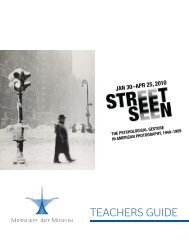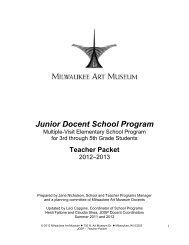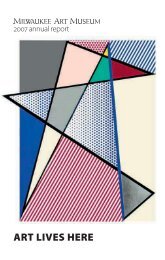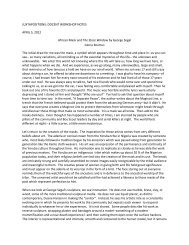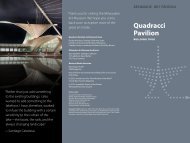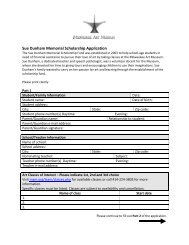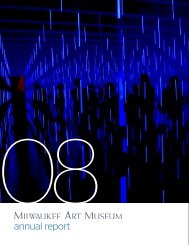Junior Docent School Program - Milwaukee Art Museum
Junior Docent School Program - Milwaukee Art Museum
Junior Docent School Program - Milwaukee Art Museum
You also want an ePaper? Increase the reach of your titles
YUMPU automatically turns print PDFs into web optimized ePapers that Google loves.
Strictly speaking, white is not a color; it results from a surface on which<br />
there is no pigment for light to reflect off of. Black results from a surface<br />
absorbing all the colors in the spectrum.<br />
All color has value. Value refers to the range of light and dark color values<br />
that artists use to express and evoke various emotional responses in<br />
artwork.<br />
PRIMARY POINT: The principles of art are the ways in which artists combine the<br />
elements of art to communicate their message. The seven principles of art are balance,<br />
rhythm (repetition), pattern, contrast (variety), emphasis (focal point), movement (visual<br />
path), and unity. When discussing an element of art, docents will refer to the principles<br />
of art, such as a balance of color, a repetition of lines, a contrast of shapes, etc.<br />
Tour Implementation Ideas<br />
The following works of art are examples that can be used with this tour. Please know<br />
this tour is not limited to the pieces listed below!<br />
The following teaching aides may be useful with this tour and are located in the<br />
Education Resource Room cabinets:<br />
line cards or yarn/rope to make lines<br />
felt board and felt pieces, including:<br />
o color wheel<br />
o three same-colored shapes in diminishing sizes<br />
o yarn<br />
o warm and cool color shapes<br />
colored foam geometric forms and a sheet of paper<br />
four circles of yellow and four different shades of the same color fadeless paper<br />
backgrounds<br />
black-grey-white value scale<br />
pairs of various one-color objects and various colored fadeless paper<br />
Line<br />
<br />
<br />
<br />
<br />
Using separate cards with one type of horizontal, vertical, or diagonal line in various<br />
widths and directional configurations drawn on each of them, show the children the line<br />
and ask them how it makes them feel (i.e. calm, tense, excited). “How do you think the<br />
lines create a different feel to a work of art?”<br />
Using a bag of various materials for making lines (rope, lace, belt, etc.) or use the felt<br />
board and a length of yarn talk about lines with the students and have them make the<br />
line you are talking about from the materials. Consider having the children sing/make a<br />
sound for each line based on how the line makes them feel (ex. horizontal line =<br />
aaaaaaahhhhhh).<br />
Choose a line in a work of art. Slowly drawing the line in the air with arm motions, ask<br />
the children to find the line in which you are describing. Discuss the type and/or quality<br />
of line in the work of art.<br />
Take a walk with a line. Instruct the students to follow and mimic you in a single- file line<br />
as you create zig-zag, diagonal, straight, and curved lines walking through the galleries.<br />
20<br />
© 2011 <strong>Milwaukee</strong> <strong>Art</strong> <strong>Museum</strong> 700 N. <strong>Art</strong> <strong>Museum</strong> Dr. <strong>Milwaukee</strong>, WI 53202<br />
JDSP – <strong>Docent</strong> Packet


